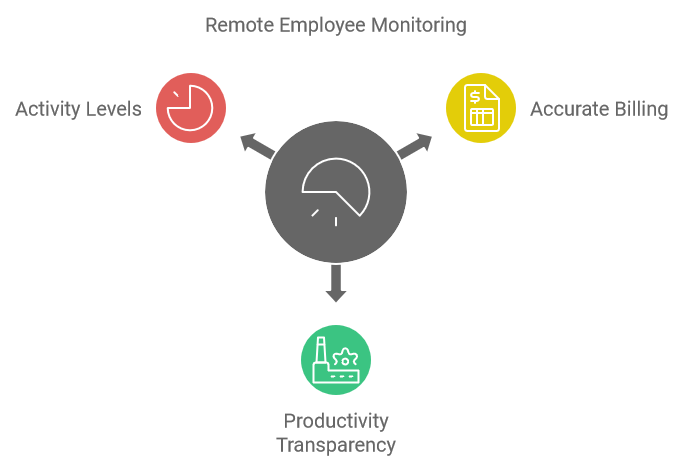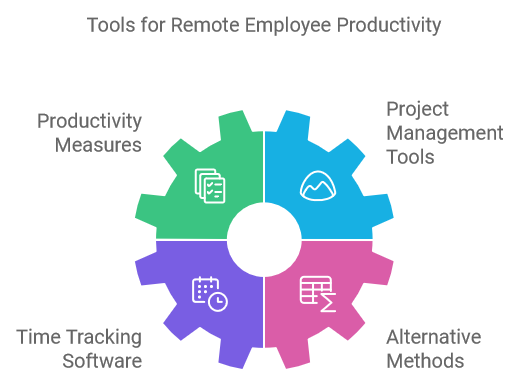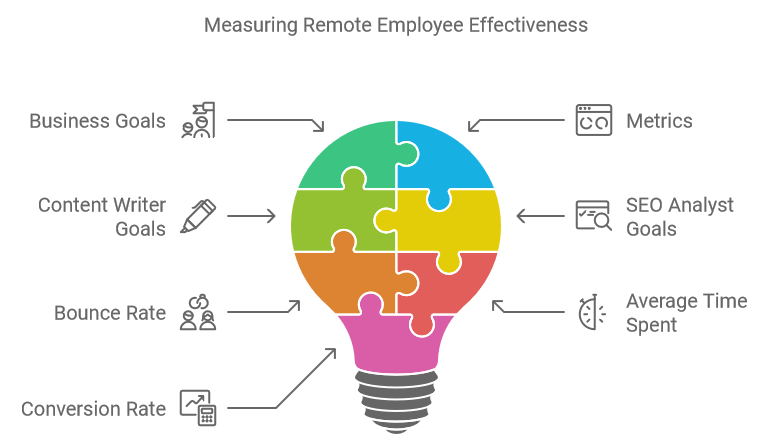Remote employee monitoring for digital marketing agencies
7 min read
Do you hire remote employees but find it hard to monitor them? You’re not alone!
Monitoring remote employees is hard. You cannot walk up to a remote employee to see what she is doing. It’s even harder to monitor a remote employee working in a different time zone or country.
Many digital agencies, outsourcing and software companies hire remote employees to get access to talent, reduce costs and increase productivity. Some of the most popular remote working roles are in these industries. As these businesses hire more remote employees, they need to put in place systems for monitoring their work.
In this post, we show you how to monitor remote employees, build trust with them, and get the best out of them.
Monitoring remote employees involves:
- Tracking input: you want to know if the employee is working the expected number of hours
- Measuring productivity: you want to measure the output of the remote employee
- Monitoring effectiveness: you want to monitor if the remote employee is delivering desired quality of work
Tracking input (hours worked) by remote employees

Tracking the input as number of hours spent by a worker is the basic requirement for monitoring remote employees. Time tracking tells you whether employees are spending required number of hours at work.
Tracking time brings transparency with remote employees and builds trust. If you pay remote employees or bill clients by the hour, then must track hours workers spend on your work. You avoid over paying remote workers and invoice clients for the correct number of hours.
You can track time by employees, clients, projects and tasks. How you use it depends on your business needs. There are many good time tracking software with different features and pricing. If you are not using one, you can use our guide to select the best time tracking software for your business.
If you are a digital agency with a fixed monthly retainer contract, you don’t need to track hours for billing clients. But you may be paying your remote employees by the hour. You will want to track the number of hours remote employees spend on your projects. Similarly, a software company that hires remote developers would want to track hours worked by the developers so it can pay them accurately.
An outsourcing company with time and material type contract with clients would have to track hours for billing clients. It would need accurate timesheets and a way to back up them up in case the client has any concerns.
You may also want to monitor remote employees’ activities to ensure they are doing the right things at work. A good time tracking software can record activity levels and take screenshots of the employee’s computer for monitoring and feedback.
Monitoring Active and Inactive time of remote employees tells you if they are working on your project or just idling away their time. If you doubt a remote employee’s timesheet, you can verify it using the screenshots. You can also use the screenshots to review their work style and give feedback for improvement.
Measuring productivity of remote employees

Productivity measures how many units of work (output) the employee delivers in a given amount of time. Measuring productivity is an important part of monitoring remote employees because it tells you if they are producing the desired output.
Some productivity measures you can use are:
- How many tasks the remote employee completes in a week or month
- Did the employee meet project deadlines/milestones
- Number of blog posts a content writer writes in a week
- New backlinks SEO analyst builds in a month
- How many posts social media marketer publishes every week
Not all of these, like lines of code written, can be tracked using a tool. But you can monitor most productivity measures for marketing, outsourcing or software development using a good project management tool. You can also use a spreadsheet to do the same but it will take more effort.
Asana and Basecamp are two of the most popular project management tools that marketing agencies, outsourcing companies and software developers use. A project management tool can track the status of projects and tasks. It can monitor whether your employees are meeting project deadlines and milestones.
Project management tools complement time tracking software. Most project management tools can track schedule but not time. Most time tracking software are good at tracking time but not so good at tracking projects and tasks. So you need a combination of these for monitoring remote employee effort and productivity.
If you don’t have the budget to spend on a project management tool, don’t worry! You can use the free version of Asana for project management. The free version is good enough for small to midsize agencies, outsourcers and software developers. All you need to do is sign-up for a free Asana account and follow our Asana project management guide.
If you don’t want to use a project management tool, you can use a simple spreadsheet to track tasks and projects. You create projects and tasks in a Google sheet and share with your remote employees. As they finish each task, they mark it complete in the sheet. You can collect additional information like number of words in a blog post or number of links created by the remote employee. While it works for very small teams, it gets too complicated once your team starts growing.
Monitoring remote employee effectiveness

Monitoring time and output of remote employees tells you if they are doing the job. But just because a remote employee is spending the required hours and delivering the expected output does not mean she is delivering the desired result for your business.
A content writer could write 2 blogs every week as expected but the blogs may not have the right keywords or may not engage visitors. Are these blog posts any good?
An SEO analyst could build 100 backlinks a month. But if these links come from low quality sites, they may not improve your SEO. In some cases, they could damage your SEO instead of improving it. Is this SEO analyst delivering the result you want?
This is why measuring effectiveness is a critical part of monitoring remote employees. Let’s dig in and see how to do it well.
The first step in measuring effectiveness is to establish clear business goals for each remote employee in your team. Business goals are different from output goals in the sense that they focus on result, not output.
Once you have defined the goal, you identify metrics to measure progress towards the goal. It’s important that you discuss both the goal and the metrics with the remote worker. She must understand why you are doing it and what she needs to do to meet your expectations.
It may sound complicated to you but is not. Let’s take the example of a few different roles in a marketing agency:
Content Writer: The goal of writing blogs is to rank in search results, bring organic search traffic to the site, and engage the visitors. An engaged visitor is more likely to spend time on your site, come back again and buy from you. You can measure whether a blog post meets these goals are not by measuring
- Bounce rate: A high bounce rate means the blog quality is low, and it’s not engaging the visitors. As a result, those visitors are clicking away from your site.
- Average time spent on the blog page: Visitors to an engaging blog post would spend more time on that page. This is also called dwell time. The longer the dwell time, the higher the blog quality and relevance to your visitors.
- Conversion rate: A blog post could have a low bounce rate and high dwell time but may not convert visitors into buyers. This indicates a low relevance to the visitors. A good blog post is not just informative and written well, it’s also relevant to your visitors.
While number of visitors to the blog page is important, it depends on how well the blog is doing in search results. The content plays a part but good SEO is plays a bigger role in attracting visitors.
SEO Analyst: SEO is about getting your site’s pages rank high in search engine results for searches that are relevant to your business. Both on-page and off-page SEO affect search engine ranking of a page. So the goal of an SEO analyst id to improve ranking in search results by optimizing the content for target keyword and building relevant links. You can measure whether the SEO is delivering on this goal by
- Improvement in search ranking for targeted keywords
- Increase in domain authority and page authority
You use specialized tools like Google Analytics, Search consoles and MozBar for measuring these metrics.
You can use these examples to set goals and measurements for other roles. For other roles, you may have to use other tools. By tracking input, measuring output and effectiveness, you get complete information for monitoring remote employees.
Summary
In this post, we discussed how to monitor remote employees. We discussed how you can track input, measure output and effectiveness of your remote employees. Together, the three help you understand how your remote employees are performing.

